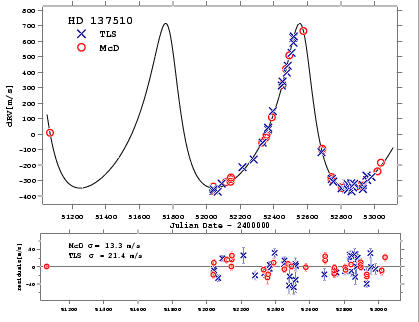HD 137510: An Oasis In The Brown Dwarf Desert
The companion to the G0IV star HD 137510 is one of the very rare objects found by planet searches which is located
in the so-called ``brown dwarf desert''. This is the nickname for the peculiar region in the mass function for spectroscopic
binaries where the secondary mass lies in between the stellar and planetary mass regime. HD 137510 b has a minimum mass of 26 M
[Jupiters]
and moves in an eccentric orbit (e = 0.4) with a period of 798 days and an orbital semimajor axis of 1.85 AU. The detection
is based on precise differential radial velocity data obtained with the 2.7 m Harlan J. Smith telescope at McDonald observatory
and the 2.0 m telescope at the Thueringer Landessternwarte Tautenburg, Germany.

Radial velocity data for HD 137510 (G0IV) from McDonald (McD, red circles) and Tautenburg (TLS, blue crosses) observatory
planet searches. The best-fit Keplerian orbital solution is plotted as a solid line. The lower panel shows the
residuals after subtraction of this orbit.
Click for larger image
Parameters of the companion and its orbit:
Period = 798.2 ± 1.4 [days]
T periastron = 2452582.01 ± 2.6 [days]
e = 0.402 ± 0.008
omega = 30.8 ± 1.2 [deg]
K = 531.6 ± 5.3 [m/s]
M sin i = 26 ± 1.4 [Jupiter]
a = 1.85 ± 0.05 [AU]
Parameters of the host star:
Spectral type = G0 IV
V = 6.3 [mag]
d = 41.75 [parsec] (based on Hipparcos parallax of 23.95 mas)
M = 1.3 ± 0.1 M [Sun]
Teff = 5896 ± 57 [K]
log g = 4.0 ± 0.1
Radius = 1.9 ± 0.2 [R Sun]
age = 3.4 ± 0.8 [Gyr]
[Fe/H] = 0.16 ± 0.07
v sin i = 4.5 - 7.5 [km/s]
References:
Endl M., Hatzes A.P., Cochran W.D., McArthur B., Allende Prieto C.,
Paulson D.B., Guenther E., and Bedalov A.
2004, ApJ, 611, 1121
astro-ph/0404584
Back to Planetary Systems
webpage by: Michael Endl
